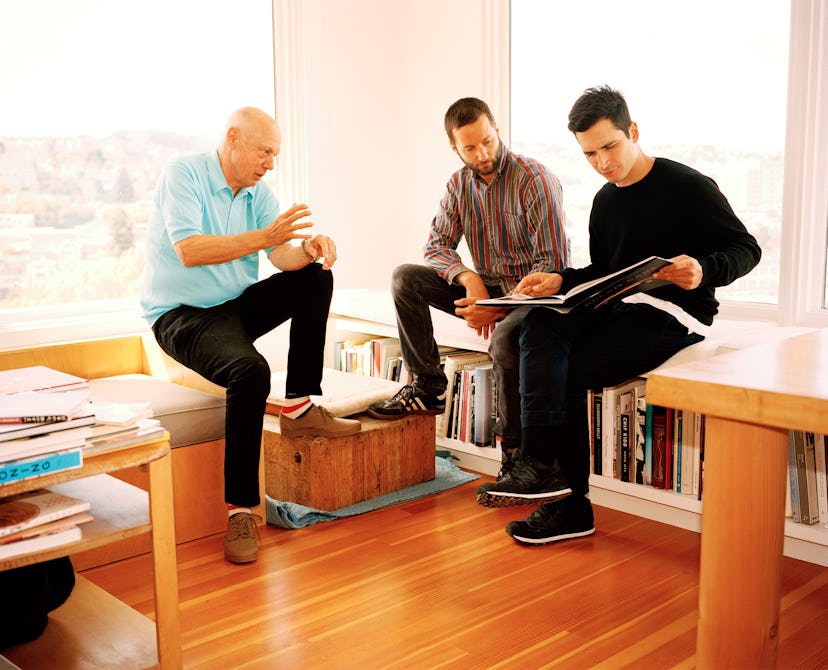Proenza Schouler + Ron Nagle

For more than 50 years, the San Francisco artistRon Nagle has been creating dauntless and provocative painted sculptures that hook the senses and elude narrow readings: a dark, luscious drip threatens to ooze down a pockmarked orb; an ultramarine monolith tilts slightly, its minimalist purity rocked by an incongruous bracketing of asphalt black, bubblegum pink, and cheese-puff orange.
When Lazaro Hernandez and Jack McCollough of Proenza Schouler first saw photographs of Nagle’s work, they were stirred by the alluring frisson of knowing and not knowing. Looking only at images of the objects, they found it difficult to discern whether the forms were brittle or spongelike, hollow or solid, massive or miniature. But they were instantly captivated by the emphatic volumes, finely calibrated tensions, complex textures, and dueling color combinations delivered in dense, shimmering layers or cross-fading mists.
In 2013, at the 55th Venice Biennale, the designers finally encountered Nagle’s work in person. In the Central Pavilion of the Giardini, the curator Massimiliano Gioni had ingeniously paired the artist’s recent “Sleep Study,” a series of 30 bracingly precise ceramic sculptures constructed just before bedtime, with a collection of modestly scaled Tantric paintings—geometric abstractions dating from between 1964 and 2004—produced in Rajasthan, India, by unknown artists. Each one of Nagle’s sculptures measured less than six inches square; displayed in a single vitrine, they appeared at once diminutive and monumental, as if a high-desert mesa had somehow been realized within the intimate dimensions of a teacup. In Nagle’s work,an impressive understanding of shapes, methods, and color is clearly evident, but it’s the artist’s instinct to whittle everything down to its essence that makes these small objects so compelling. When Hernandez and McCollough showed their fall 2014 collection, they cited Nagle’s installation in Venice as a major inspiration.
In late September, following New York Fashion Week and a restorative break on Kauai, Hernandez and McCollough made a stop in San Francisco to visit Nagle’s Bernal Heights studio and mull over the perennial issues of inspiration and process. Small objects were lined along the edge of a table. Nagle described his works as three-dimensional paintings—he starts from drawings, which he then translates into clay. As he walks about the city, he collects imagery and textures: walls graffitied with bubble letters, the coarse pebble dash and starched lace stucco finishes on local houses, a puddle of oil swirling in the gutter. His studio and living room library are stacked with exhibition catalogs, magazines, and tear sheets stored in plastic sleeves. “I find a lot of colors in magazines, especially articles about Japanese food preparation and fashion advertisements,” he told Hernandez and McCollough, as he casually fielded their questions. Leafing through a pile of tear sheets, he pulled up a recently archived advertisement and handed it to them: It was a picture of a bright aqua Proenza Schouler shoulder bag named Riptide. The designers beamed and said they felt as if they’d come full circle.
Photos: Proenza Schouler + Ron Nagle
Ron Nagle, with Jack McCollough and Lazaro Hernandez. Photograph by Jake Stangel.
Nagle’s San Francisco studio. Photograph by Jake Stangel.
Nagle’s Handlin’ Bambi, 2014. Photograph by Jake Stangel.
Inspiration tear sheets in Nagle’s studio. Photograph by Jake Stangel.
A Proenza Schouler runway look from fall 2014. Courtesy of CNP Montrose.